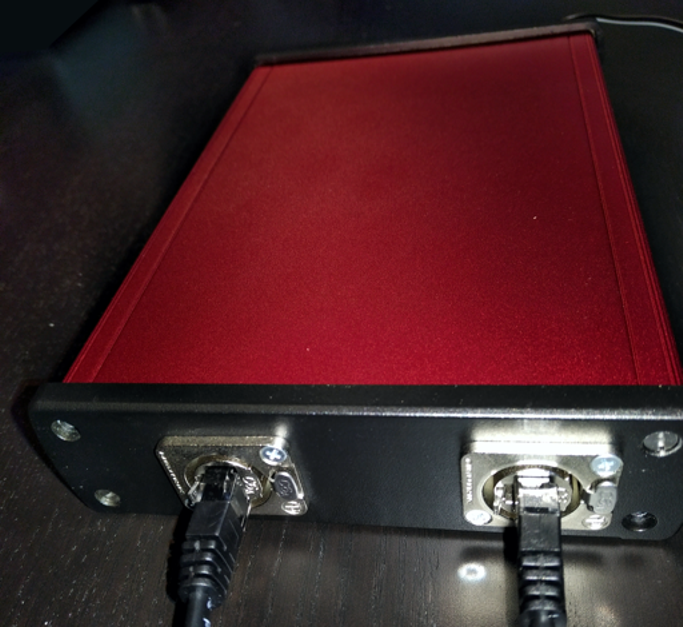
The ArtNET DMX adder can calculate values with offsets in real-time DMX values. This is especially interesting when moving head fixtures were incorrectly hung up and you have little time to adjust your mixing console programming. To correct this, the ArtNET DMX adder can add a programmable offset to the PAN and / or TILT values in real time.
Following problem:
As an external lighting designer and operator you get the setup of a stage on a festival weeks before the concert. All fixture types, their positions on the stage and their DMX addresses. The direction in which the moving head fixtures are mounted on the stage, typically with the display to the stage center, is also discussed.
As a modern lighting designer for concerts one creates athe stage by using the Martin Show Designer for example. With all fixtures on their positons and with their DMX addresses.
Then you program your Lightcontroller Cuelists for the show. On the basis of the showsimulation one can verify the effect of the Cuelists and perfection its design. In the Cuelists, the beam positions for the moving heads are also stored, in addition to colors and shapes.
Everything is good and you go to the festival. Once there, you connect your controller to the ArtNET or DMX system on the stage and start a cuelist with a moving head position. And one is frightened: The positions of the light beams do not match those of the simulation. For example, they are rotated by 90 degrees horizontally.
This can have two reasons: Once the simulation of the fixtures in the Show Designer can be incorrectly programmed or the technicians have installed the real lamps on the stage in an incorrect orientation. No matter what the reason is: Now, at the hour you have a real problem.
What to do? The fixtures on the real stage are no longer accessible, the festival is already running.
You could now correct each individual stored position in the controller. This is simply impossible with complex lighting. Or you use my development: The ArtNET DMX Adder
ArtNET DMX Adder - Prototype V1:
The ArtNET DMX adder can correct DMX values in ArtNET packages by an offset in real-time.
My prototype V1 is running on an Arduino M0 board with an Ethernet shield on top.

If you have to drive the stage from the FOH via DMX, then you can now do the following:
- Connect the DMX Adder to the mixing console via a network router.
- An ArtNET2DMX gadget is also connected to the same network router.
- If you use the Martin M series as mixing console, you can now have all ArtNET packets sent to the IP of the Artnet DMX adder
- The DMX adder, in turn, makes a network broadcast to all connected devices in the network, in which case the ArtNET2DMX gadget receives these packets.
- The ArtNET2DMX gadget converts the ArtNET packages into DMX signals and sends them to the stage.
ArtNET DMX Adder - Prototype V2:
My prototype V2 now has two Ethernet ports. So you can switch the adder directly between the mixer and the Ethernet line to the stage:
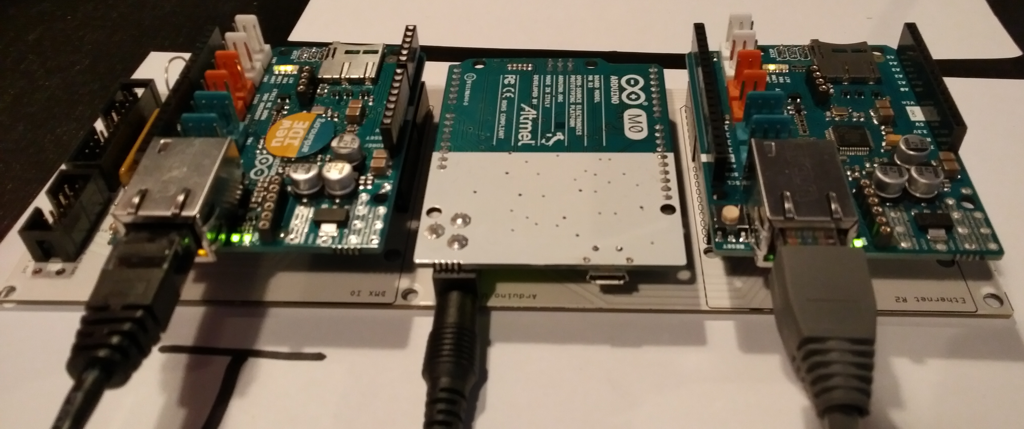
The ArtNET DMX Adder now works as a router of all ArtNET packages.
Now you just have to tell the ArtNET DMX adder which DMX values he should offset with an offset (positive or negative, depending on how the moving heads are aligned). This is done directly via the mixing console:
- In the mixer, a well-known moving head position is used, the beams are still in the wrong direction
- Now you are sending on the same universe on the channel 512 a value over 63 and below 127: This tells the ArtNET DMX adder to correct this universe.
- Now, a value greater than 127 is sent on channel 512: This tells the DMX adder that now correction values will follow.
- Now use the console to set the correct positions of the moving heads for the light image. For example, you correct the PAN positions of all moving heads so that the picture is right on the stage. These values are registered by the DMX adder.
- Then send the DMX adder on channel 512 a value below 63: This tells the adder: It should remember the difference between the output values of all channels and the corrected values as delta.
From now on, the ArtNET DMX Adder adds the delta values in real-time onto all DMX values of the universe used. These can also be negative.It now corrects the PAN positions of all moving heads in real time, for example.
In this video you can see the process, done by the prototpe V1:
In this video you can see the prototype V2 as it is interposed in an existing Ethernet route to the stage:
All cuelists with moving head positions are constantly corrected and the moving heads produce the desired lighting picture on the stage.
The ArtNET DMX Adder has a web interface with which you can adjust its setup and can also see which DMX values are corrected in which universe:
Thanks to Sylvain Guiblain for the cooperation on the webinterface.
Technical data of the prototype V2:
Processor Board: Arduino M0
Ethernet: 2 x Ethernet Shield 2 (Dual Ethernet for Arduino)
Motherboard: Own design
Up to 8 DMX universes can be corrected
Web interface for setup and control
Hardware costs: about 130 euros
Power supply: 5 V / 500 mA
ArtNET DMX Adder - Prototype V3:
The prototype V3 is built on a new motherboard, which can be pushed directly into a suitable aluminum housing. Here you can still see the structure with sockets:
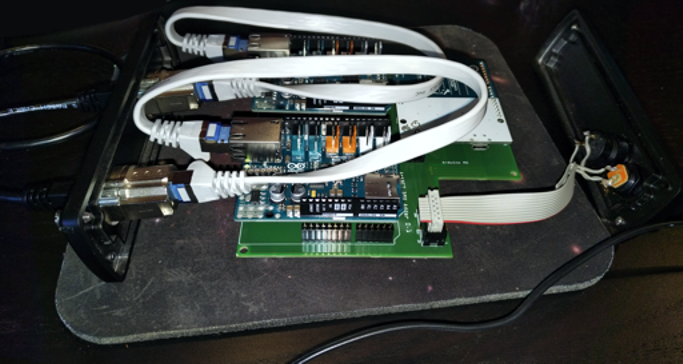
In the next step, the EthernetShields were soldered directly onto the motherboard to make the sandwich flatter and fit into the chassis:
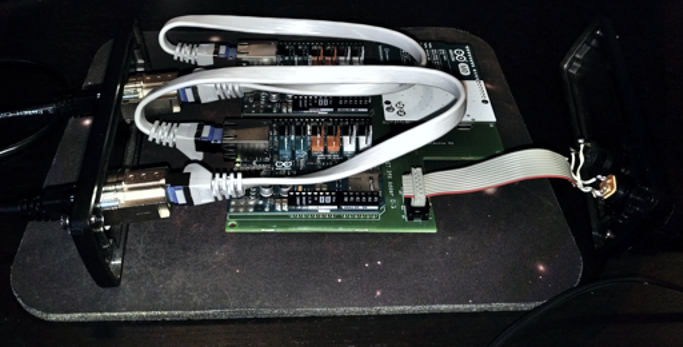
Finally the motherboard with all the wires was pushed into the housing and screwed:
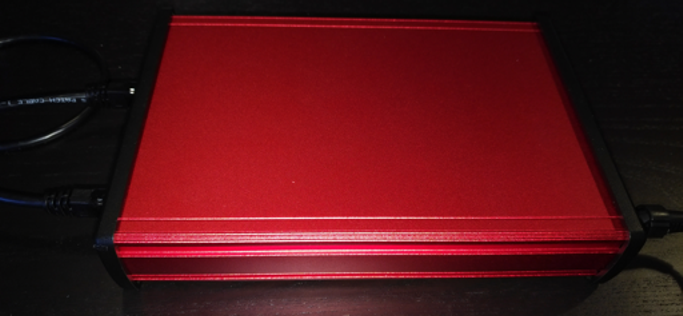
Testing:
The ArtNET DMX Adder prototype V3 has surpassed an endurance test time span of over 12 hours with 4 ArtNET universes. 1.6 million network packets were transported and converted. Besides, he has always renewed his webpage. A maximum of 13 packets per DMX universe have been lost (this happens, unfortunately, if the Autorrefresh is activated). The CPU load of the processor is 52% for 4 universes. The ArtNET DMX Adder prototype V3 can therefore process a maximum of 8 DMX universes at a packet rate of 24 per second and per universe.
Future:
For more than 8 DMX universes you need a more powerful processor board, most likely with an embedded Linux on it. Well, if I had time ...
Should you as a manufacturer of light equipment have interest in this project or product, please This email address is being protected from spambots. You need JavaScript enabled to view it. me.







